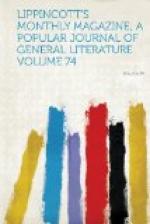It was not until after passing the elevated site of San Pedro, and clambering up the slippery shoulders of the hill called Huaynapata—the crossing of half a dozen intervening streamlets going for nothing—that the explorers were rewarded with a sight of their Canaan, the bark-producing region. To attain this summit of Huaynapata, however, the little tributary of Mendoza had to be first got over. This affluent of the Cconi, flowing in from the south-south-west, was very sluggish as far as it could be seen. Its banks, interrupted by large rocks clothed with moss, offered now and then promontories surrounded at the base with a bluish shade. At the end of the vista, a not very extensive one, a quantity of blocks of sandstone piled together resembled a crumbling wall. Other blocks were sprinkled over the bed of the stream; and by their aid the examinador and the colonel hopped valiantly over the Mendoza, leaving the peons, who were less afraid of rheumatism and more in danger of slipping, to ford the current at the depth of their suspender-buttons.
It was on the top of Huaynapata, while the interpreters built a fire and prepared for supper a peccary killed upon the road, that Marcoy observed the examinador holding with his Bolivians a conversation in the Aymara dialect, in which could be detected such words as anaranjada and morada. These were the well-known commercial names of two species of cinchona. The historiographer interrupted their conversation to ask if anything had yet been discovered.
“Nothing yet,” replied the examinador; “and this valley of the Cconi must be bewitched, for with the course that we have taken we should long ago have discovered what we are after. But this place looks more favorable than any we have met. I shall beat up the woods to-morrow with my men, and may my patron, Saint Lorenzo, return again to his gridiron if we do not date our first success in quinine-hunting from this very hillock of Huaynapata!”




